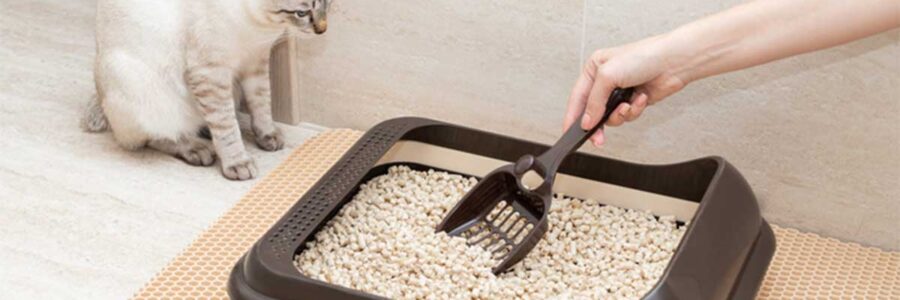Cat litter is an important aspect of feline care, providing cats with a designated space to eliminate waste while keeping their living area clean and odor-free. However, not all cat litter is created equal, and some may pose significant health risks to both cats and their owners.
This article explores the potential dangers associated with cat litter, including the accumulation of ammonia, the toxic nature of certain litter materials, and the risk of Toxoplasma gondii infection. By providing this information, cat owners can take proactive measures to minimize these risks and promote the health and well-being of their feline companions.
Ammonia Buildup in Cat Litter
Ammonia is a compound formed by urea decomposition.1 As cat litter absorbs urine, ammonia can accumulate. Prolonged exposure to high ammonia levels can lead to respiratory problems in cats and humans. In cats, this may manifest coughing, wheezing, or difficulty breathing, while in humans, symptoms may include throat irritation and difficulty breathing. Ammonia vapors can also cause eye irritation in both cats and humans.2
Chronic exposure to ammonia can weaken the immune system, making cats and humans more susceptible to infections and other health problems.3 To minimize ammonia buildup, cleaning the litter box regularly is crucial. Scoop out waste daily, and empty the litter box with mild soap and water at least once a week.4 Some cat litter brands advertise low-ammonia or ammonia-neutralizing properties. These litters may contain zeolite, which can help control ammonia levels.5 It is also important to ensure the litter box is placed in a well-ventilated area to dissipate ammonia fumes and reduce the risk of respiratory issues.6
Toxic Components in Cat Litter
Some common litter ingredients can harm cats and humans, even when the litter is clean. For example, sodium bentonite, a common ingredient in clumping cat litter, can cause respiratory and digestive issues in cats when ingested or inhaled, as it can expand and harden when wet.7 Silica gel crystals, used in some cat litters to absorb moisture and odors, can cause respiratory irritation if inhaled by cats or humans.8
Many cat litters contain fragrances and chemicals to mask odors, which can cause allergic reactions, skin irritation, or respiratory issues in sensitive cats and humans.9 Ingesting litter containing sodium bentonite or harmful chemicals and additives can cause blockages in the digestive system or toxicity in cats, resulting in symptoms such as vomiting, diarrhea, or lethargy.10 Cat owners should avoid litters containing potentially harmful ingredients and choose safer alternatives made from biodegradable and natural materials.11,12 Opting for unscented cat litter can also help minimize the risk of allergic reactions or respiratory issues related to fragrances and chemicals.13
Toxoplasma Gondii in Cat Litter
Toxoplasma gondii is a parasite that can infect various warm-blooded animals, including cats and humans.15 Cats become infected by ingesting tissue cysts from infected prey or consuming contaminated food or water.16 Once infected, cats can shed millions of oocysts in their feces, which can contaminate the litter box.17 Toxoplasma gondii infection can cause varying severity of symptoms in cats, ranging from mild gastrointestinal issues to more severe signs such as fever, weight loss, and neurological problems.18
Conclusion
Conclusively, cat litter is a critical component of feline care, but it can pose significant health risks to cats and their owners. Ammonia buildup, toxic litter components, and the threat of Toxoplasma gondii are some dangers associated with cat litter. To minimize these risks, cat owners should regularly clean the litter box, choose safer cat litter alternatives, and practice good hygiene.
Using biodegradable and natural options, opting for unscented cat litter, and avoiding litters containing ingredients such as sodium bentonite, silica gel crystals, or harmful fragrances and chemicals are all excellent steps to take. Keeping cats indoors and providing them with balanced diets and regular vet check-ups is also essential. By taking proactive steps to minimize these risks and choosing safer cat litter alternatives, cat owners can help ensure the health and well-being of their feline companions.
References:
- Dewes G, Amon T. Ammonia emissions from a non-acidifying and a conventional pig manure during anaerobic storage. Bioresource Technology. 1999;68(1):11-17.
- Agency for Toxic Substances and Disease Registry (ATSDR). Toxic Substances Portal – Ammonia. 2004. Available from: https://www.atsdr.cdc.gov/substances/toxsubstance.asp?toxid=19.
- Suttie JW, Gaines RG, Gray LE. The effect of ammonia on the growth of rats and the immune response of mice. The Journal of Nutrition. 1963;80(2):173-179.
- ASPCA. Litter Box Care. Available from: https://www.aspca.org/pet-care/cat-care/litter-box-care.
- Lopez CJS, Lachica SPL, Sanchez JFS. Ammonia and greenhouse gas emissions from high-rise layer houses with different litter treatments. Journal of Environmental Management. 2018;206:1020-1029.
- Pierzynski SG, Sims JT, Vance GF. Soils and Environmental Quality. CRC Press; 2005.
- Tell LA. Avian and Exotic Animal Hematology and Cytology. John Wiley & Sons; 2013.
- Cutler TJ. Silica Dust Exposures during Selected Construction Activities. AIHA Journal. 2003;64(3):319-328.
- Portnoy JM, Kennedy CS, Sublett JL. Environmental Assessment and Exposure Control of Dust Mites: A Practice Parameter. Annals of Allergy, Asthma & Immunology. 2011;107(6):S406-S432.
- Mitchell MA, Tully TN. Manual of Exotic Pet Practice. Elsevier Health Sciences; 2008.
- Peterson ME. The Cat: Clinical Medicine and Management. Elsevier Health Sciences; 2011.
- Buffington CAT. External and internal influences on disease risk in cats. Journal of the American Veterinary Medical Association. 2002;220(7):994-1002.
- Dubey JP. Toxoplasmosis of Animals and Humans. CRC Press; 2016.
- Dubey JP, Sreekumar C. Redescription of Toxoplasma gondii oocysts. International Journal for Parasitology. 2004;34(3):255-267.
- Innes EA. A brief history and overview of Toxoplasma gondii. Zoonoses and Public Health. 2010;57(1):1-7.
- Dubey JP. Toxoplasmosis in cats: The last 20 years. Veterinary Parasitology. 1999;82(3-4):213-231.
- Lappin ML. Update on the diagnosis and management of Toxoplasma gondii infection in cats. Topics in Companion Animal Medicine. 2010;25(3):136-141.


